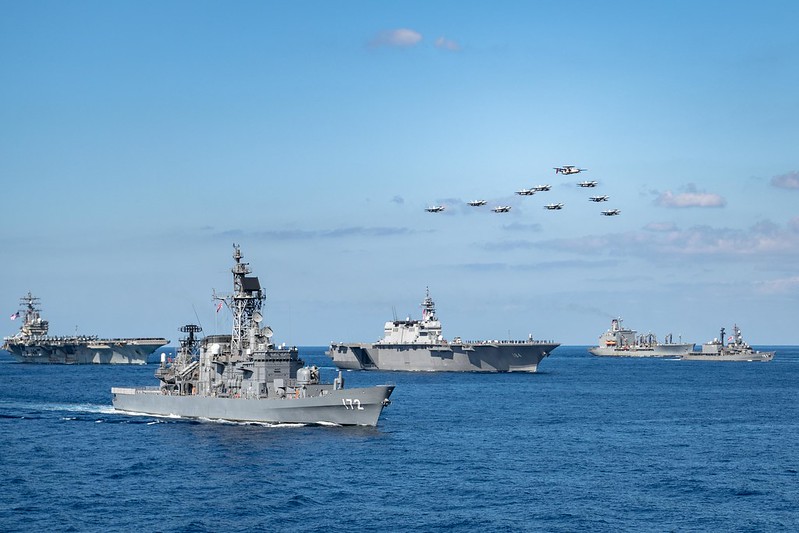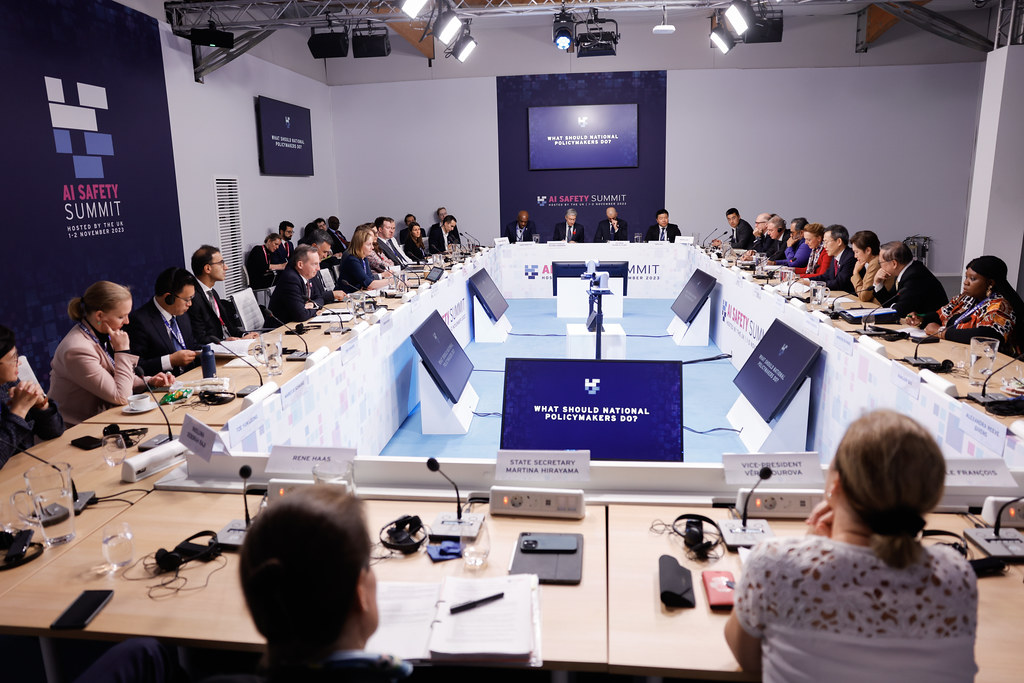Water Wars: Shadowboxing in Taiwan and the Senkakus
Tension around “Fortress Taiwan,” concern for the Senkakus, and naval exercises in the South China Sea.

Published by The Lawfare Institute
in Cooperation With

An uptick in Chinese military activity around Taiwan and China Coast Guard presence at the Senkakus have kept the region on edge. Beijing seems keen to use military action short of war to test both maritime boundaries and the patience of officials in Taipei, Tokyo and Washington. Such a “shadowboxing” strategy is consistent with long-standing Chinese efforts that began at least in 2012 to “win without fighting” in the South and East China Seas. But the strategy is hardly novel, as it is a core premise in Sun Tzu’s Art of War: “to fight and conquer in all your battles is not supreme excellence; supreme excellence consists in breaking the enemy’s resistance without fighting.” Resistance from Taiwan, Japan and the United States, however, shows little sign of breaking.
Fortress Taiwan
The Chinese People’s Liberation Army (PLA) held a large-scale military exercise in the provinces bordering Taiwan to simulate an island invasion on Oct. 10, coinciding with Taiwan’s National Day. The exercise demonstrated joint integration among China’s military branches and featured drones, special forces and airborne troops. A video released by Chinese state media depicted live-fire rocket launches and a nighttime amphibious landing. The same day, Taiwanese President Tsai Ing-wen delivered a speech urging the People’s Republic of China (PRC) to engage in peaceful dialogue with the island nation. In addition to increased PLA live-fire exercises around Taiwan, PLA aircraft have continued to violate Taiwan’s Air Defense Identification Zone (ADIZ)—airspace in which Taiwanese authorities identify, locate and control inbound aircraft—despite repeated protests from Taipei. Taiwan’s Ministry of National Defense reports that nearly 40 days of PLA ADIZ incursions have occurred since mid-September.
Apart from shadowboxing PLA aircraft, Taiwan has been encountering another intruder: Chinese sand thieves. Civilian vessels from mainland China have reportedly been converging on Taiwan’s Matsu Islands (Mandarin: Mǎzǔ Lièdǎo) to extract sand, sometimes appearing in numbers of 400–500 Chinese vessels. The islands are more than 100 nautical miles from Taiwan but only 10 nautical miles from the mainland Chinese province of Fujian. Whether the Chinese vessels are dredging sand for commercial purposes or as an intimidation tactic is unclear. One Taiwanese analyst found the action analogous to the ADIZ incursions as a PRC gray zone tactic—coercive aggression below the threshold of war to exhaust Taiwanese resources responding to incursions. Taiwan has confiscated at least six Chinese sand dredgers this year, before fining the operators or selling the ships. Taiwan’s Coast Guard Administration also posted a video in October of one of its vessels using a water cannon to drive away a Chinese sand dredger.
Halfway between Hong Kong and Taiwan lie the Pratas Islands (Mandarin: Dōngshā Qúndǎo), one more set of Taiwan-occupied but PRC-claimed features causing heartburn in Taipei. The features consist of one island (Pratas) and various atolls, lying in the South China Sea approximately 170 nautical miles southeast of Hong Kong and 240 nautical miles southwest from Taiwan. The island made an expected appearance in Hong Kong’s unrest this summer: In July, five Hong Kong protesters fled the city’s crackdown and sought political asylum in Taiwan, but the Taiwan Coast Guard picked them up near the Pratas Islands. It is unclear if the protesters sought refuge at Pratas or merely drifted to the islands after their boat reportedly ran out of fuel.
Already disputed territory between China and Taiwan, Pratas Island could further incense PRC authorities if it becomes a beacon for Hong Kong asylum-seekers. The island is the closest territory to Hong Kong not under Beijing’s control. PLA military drills in August allegedly simulated an amphibious invasion of Pratas. Taiwan responded to reports about the PLA drills by increasing the number of Taiwan Marines and Coast Guard officers on the island. Taiwan also plans to station unmanned Albatross drones on Pratas for reconnaissance and to respond to “unexpected situations.”
However, on Oct. 15, Hong Kong’s Civil Aviation Department blocked a Taiwanese military-charter plane from entering Hong Kong airspace while flying to Pratas. The flight was a weekly, routine flight to transport military personnel to and from the island. Hong Kong civil aviation authorities directed the plane to turn back to Taiwan due to “dangerous activities” in the area, without elaborating on where the danger was. The authorities seemed to be referring to the PLA live-fire exercises near Pratas, activities that have increased in scale and frequency around Taiwan since this summer. Taiwan’s defense minister denied that the flight path put its aircraft in any danger. The Taiwanese plane was later able to land at Pratas on Oct. 26 without incident.
Washington has been increasingly outspoken in its support of Taiwan in the face of recent Chinese activities. On Oct. 14, USS Barry (DDG 52) transited through the Taiwan Strait, marking the 10th transit this year. Then, on Oct. 16, U.S. National Security Adviser Robert O’Brien said that Taiwan needs “asymmetric and anti-access area denial strategies” to “fortify itself in a manner that would deter the Chinese from any sort of amphibious invasion or even a gray zone operation against them.” In other words, O’Brien is saying that Taiwan needs to mirror China’s strategy that constrains the deployment of opposing forces into a given theater and reduces their freedom of maneuver. Such a strategy could deter an outright Chinese invasion or even coercive actions below the threshold of war.
Soon after O’Brien’s remarks, China-based military analysts said that China has upgraded its southeast coastal forces “as it prepares for a possible invasion of Taiwan.” Reports of Chinese upgrades include deployment of the DF-17 advanced hypersonic missile to the provinces bordering the Taiwan Strait. The PLA has also reportedly deployed Russian-made S-400 surface-to-air missile systems to its southern shoreline in order to engage any Taiwanese missiles or aircraft. The ranges of the S-400 from the mainland cover all of Taiwan, effectively enabling China to shoot down Taiwanese aircraft as soon as they take off. But concerns over an imminent Chinese invasion of Taiwan have persisted for more than 70 years, and the reports from inside China are more likely bluster aimed at Taipei and Washington than serious preparations for invasion.
The Trump administration’s support of Taiwan includes an uptick in arms sales. Between Oct. 21 and Nov. 3, the U.S. State Department approved three arms packages for Taiwan. The sales include $600 million for unmanned maritime patrol aircraft, $1.8 billion for 135 Boeing AGM-84H land-attack missiles and various artillery systems, and $2.37 billion for 100 anti-ship and land-attack Harpoon Coastal Defense Systems. The sales embody the “fortress Taiwan” strategy that aims to deter amphibious invasion or attack from the PRC. The weapons systems also pose significant offensive capabilities to strike—preemptively or otherwise—targets such as missile or radar systems in mainland China.
China denounced the sales as actions that could cause “serious consequences” to U.S.-China relations. Beijing then announced sanctions on U.S. defense contractors Boeing Defense, Lockheed Martin and Raytheon in response to the arms sales. It is unclear what effect the sanctions will have on Boeing Defense’s parent—the Boeing Company—which has substantial business in the PRC.
There are also media reports of military-to-military exchanges between U.S. and Taiwanese forces. On Nov. 9, U.S. Marines allegedly began training with Taiwanese Marines in Kaohsiung, Taiwan. Taiwanese media called it “the first public acknowledgment of U.S. Marines training in Taiwan in over 40 years,” since the formal cessation of diplomatic relations between the United States and Taiwan in 1979. Taiwan’s Naval Command said that U.S. Marine Raiders—the Special Operations regiment of the Marines—would train Taiwanese Marines in assault boat and speedboat infiltration operations to improve the combat capabilities of Taiwanese troops.
However, Taiwan’s Ministry of National Defense walked back the statements on Nov. 12 by saying the training details divulged by the Naval Command were “not consistent with the facts.” A Pentagon spokesman also refuted the reports as “inaccurate” but did not elaborate on what training was occurring. The spokesman reaffirmed both the One-China policy and the Taiwan Relations Act, which requires the U.S. government to “make available to Taiwan” defense equipment to “enable Taiwan to maintain a sufficient self-defense capability.” In response to the mixed reporting, Chinese state media dismissed the training as insignificant because, in its view, Taiwan’s military “is limited and would collapse at the first blow.”
Then, on Nov. 10, U.S. Secretary of State Mike Pompeo said in a radio interview that “Taiwan has not been a part of China.” He added that there was bipartisan support in Washington for Taiwan and that the island nation serves as “a model for democracy.” In response, a Taiwanese Foreign Ministry spokeswoman thanked Pompeo and said, “It is true and it is the status quo that the Republic of China, Taiwan is an independent sovereign country and not part of the People's Republic of China.” Pompeo’s remarks—unsurprisingly—did not go over well in Beijing. A Chinese Foreign Ministry spokesman responded by saying that “any behaviour that undermines China’s core interests and interferes with China’s domestic affairs will be met with a resolute counterattack by China.”
In the East China Sea
On Oct. 26, U.S. and Japanese forces commenced their 10-day biennial exercise Keen Sword on and around Okinawa, Japan. Approximately 37,000 Japanese and 9,000 U.S. military personnel—along with 20 ships and 170 aircraft—participated in the air, sea and land exercise. This year’s Keen Sword also included cyber and electronic warfare training, as well as participation from the Royal Canadian Navy. The commander of U.S. Forces Japan said the exercise demonstrated U.S. capability to “deploy combat troops to defend the Senkaku Islands.”
The disputed Senkaku Islands (Mandarin: Diàoyú Dǎo) in the East China Sea have been a source of long-simmering tension between Japan and China. Japan occupies and administers the islands—totaling a surface area of only 2.5 square miles—while China and Taiwan also claim them. In 2014, President Barack Obama affirmed that the U.S.-Japan Treaty of Mutual Cooperation covers defense of the Senkakus.
Chinese Communist Party mouthpiece the Global Times painted the U.S. commander’s security assurances over the Senkakus as “war deterrence to China in accordance with the Trump administration’s strategy to provoke regional disputes to contain China.” The Global Times concluded that while “US provocation may encourage Japanese right-wing forces to take action” at the Senkakus, “defending Japan is not the US’ top interest, so Washington will think twice before it sends troops to a war zone.”
China Coast Guard vessels have spent a record 285 days this year near the Senkakus, surpassing last year’s record of 282 days. In apparent response to the U.S. commander’s remarks, two China Coast Guard vessels entered and remained within the Senkakus’ 12-nautical-mile territorial sea for 2.5 days, from Nov. 1 to Nov. 3. Japan Coast Guard vessels warned the Chinese vessels to leave and protested through diplomatic channels. In response, China’s Ministry of Foreign Affairs spokesman said the islands were “China’s inherent territory,” adding that “[p]atrolling and carrying out law enforcement activities in the relevant waters are also China’s inherent right.”
Chinese ship incursions into the Senkaku waters began in significant numbers in 2012, after the Japanese government bought the islands from a private Japanese owner. Since mid-2019, Japan has detected between 68 and 132 Chinese vessels per month within the Senkakus’ 24-nautical-mile contiguous zone; earlier ranges from 2012 to 2015 were 21–124 Chinese vessels per month. The number of Chinese vessels within the Senkakus’ 12-nautical-mile territorial sea has remained steady since 2014 at a range of 0–14 per month. Japan sees China’s maritime activities as a deliberate attempt to undercut Japan’s sovereignty claims, with Japan’s chief cabinet secretary saying that “Japan will handle this situation firmly but calmly against China.”
The Senkakus will be one of many volatile security issues in Asia for President-elect Joe Biden. On a Nov. 12 phone call, Japanese Prime Minister Yoshihide Suga spoke with Biden and reportedly received reassurances that the Senkakus fell under Article V of the U.S.-Japan Treaty of Mutual Cooperation. Article V obligates the United States to come to Japan’s defense when there is an “armed attack against either Party in the territories under the administration of Japan” (emphasis added). The Biden transition team’s readout of the call did not mention the Senkakus explicitly but underscored Biden’s “deep commitment to the defense of Japan and U.S. commitments under Article V.”
In the South China Sea
The test DF-26B and DF-21D anti-ship ballistic missiles that China launched in August hit their designated target, according to a recent report from the South China Morning Post. China launched the DF-26B from the northwestern province of Qinghai and the DF-21D from eastern Zhejiang province. A former PLA senior colonel who now works as a professor at Beihang University in Beijing claims both missiles hit their target vessel near the Paracel Islands (Mandarin: Xīshā Qúndǎo; Vietnamese: Quần đảo Hoàng Sa). China had launched the missiles several weeks after dual U.S. carrier strike group operations in the South China Sea and a day after a U.S. U-2 reconnaissance plane entered a no-fly zone during a live-fire drill in China’s northern Bohai Sea.
The alleged success of the ballistic missile launches has not stopped U.S. naval operations in the disputed waters. Fresh from its freedom of navigation operation (FONOP) near the Paracels on Oct. 9, USS John S. McCain (DDG 56) joined warships from Japan and Australia on Oct. 20 to participate in a trilateral exercise in the South China Sea. U.S. Pacific Fleet said the vessels conducted surface, subsurface and air defense exercises. The Ronald Reagan Carrier Strike Group also operated in the South China Sea in mid-October, after returning from the Indian Ocean through the Strait of Malacca.
In Other News
Selling Arms
China has reportedly armed the Venezuela Navy with C-802A anti-ship missiles. The Venezuela Navy revealed the acquisition on Sept. 25. President Nicolás Maduro’s Twitter account posted a video that shows the test launch of a C-802A missile, although the footage is from a Royal Thai Navy test firing of a C-802A. Analysts suspect Venezuela’s Guaiquerí-class patrol boats will carry the missiles.
Japan announced that it intends to export defense equipment and technology to Vietnam. Japanese Prime Minister Suga formalized the arrangement in Hanoi on his first foreign trip as prime minister, before traveling to Indonesia. In 2014, Prime Minister Shinzo Abe lifted Japan’s ban on the transfer of military equipment and technology; Abe’s first trip abroad after taking office was also to Vietnam. Suga called Vietnam “crucial to achieving [Japan’s] vision of ‘the Free and Open Indo-Pacific.’” He and Vietnamese Prime Minister Nguyen Xuan Phuc drew not-so-subtle references to China in a joint press conference, with Suga stating, “Unfortunately in this region, there is a move in the South China Sea that goes against the rule of law and openness stated in this ASEAN Outlook.” China took note, with a Global Times article citing a Chinese analyst saying, “The defense deal with Vietnam apparently exposed Japan’s trick, which is to attract more countries to meddle in the South China Sea issues, thus containing China.”
Using Arms
A new draft law in China would authorize the China Coast Guard to use armed force in China’s “jurisdictional waters.” Known for its aggressive tactics toward other South China Sea claimants, the China Coast Guard would be allowed under the new law to use small arms or shipborne weapons, such as deck-mounted guns, against vessels acting “illegally” in “jurisdictional waters.” Since 2018, the China Coast Guard has been an arm of the Chinese military as part of the People’s Armed Police military branch. China’s National People’s Congress Standing Committee is seeking public comments on the draft law through Dec. 3, after which it may become law.
Analysis
At War on the Rocks, Walter Lohman and Frank Jannuzi argue that “strategic ambiguity” over U.S. defense of Taiwan remains the best way to secure U.S. interests and a free Taiwan. They write that abandoning the island nation “would send a shock wave through American security alliances and would mark the end of U.S. leadership in the Indo-Pacific.” Lohman and Jannuzi insist, however, that an unambiguous security guarantee would hinder U.S. “strategic autonomy,” risk war with China and endanger Taiwan. A future administration in Taipei could be more reckless in provoking a war with China that then compels U.S. military intervention, they argue.
Sebastian Strangio at the Diplomat writes that the Biden administration’s strategy for Southeast Asia will reinvest in diplomacy and coordinated lines of effort across U.S. agencies, after four years of “incoherence” under the Trump administration. One area that will not change, according to Strangio: “a hawkish position on China” that represents one of the few areas of strong bipartisanship. While there may be a more cautious approach to China comparable to that seen in the Obama years, Strangio anticipates that FONOPs in the South China Sea and serious economic engagement with Southeast Asian partners will be part of the continued U.S. “full-court press against Beijing.” In addition to President-elect Biden’s public statements over the coming weeks, his pending Cabinet appointments will further signal the direction of his administration’s Indo-Pacific strategy.





